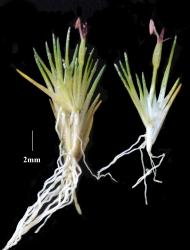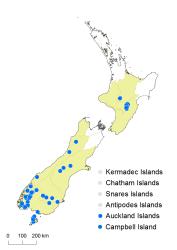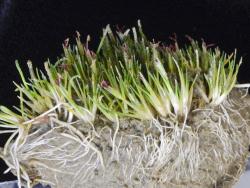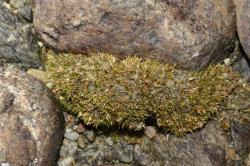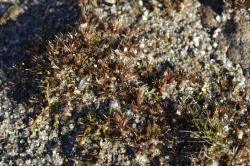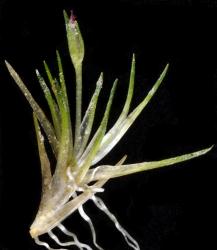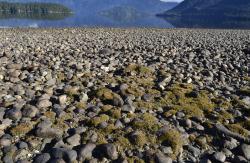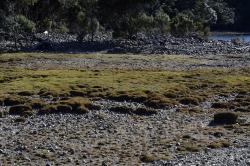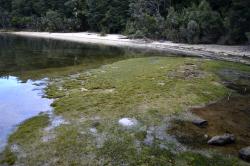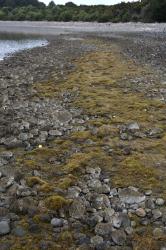- Taxon
- Gallery
- ≡ Gaimardia pallida Hook.f., Bot. Antarct. Voy. I. (Fl. Antarct.) Part I, 86 (1844)
- ≡ Alepyrum pallidum (Hook.f.) Hook.f., Bot. Antarct. Voy. II. (Fl. Nov.-Zel.) Part I, 268, t. 62 C (1853)
- ≡ Pseudalepyrum pallidum (Hook.f.) Dandy, J. Bot. 70: 331 (1932)
- = Centrolepis minima Kirk, Trans. New Zealand Inst. 23: 441 (1891)
- ≡ Pseudalepyrum minimum (Kirk) Dandy, J. Bot. 70: 331 (1932)
Perennial cushion, 8–45 mm high. Stems ascending, branching. Leaves distichous, cauline and imbricate, weakly spreading to erect. Leaf-sheath 2.8–6.5 mm long, scariose, glabrous. Leaf-sheath auricles absent; aligulate. Leaf-lamina 1.5–5.5 × 0.3–0.8 mm, ensiform to subulate, with an acute or acuminate apex, terete to compressed, glabrous. Uppermost leaf normal. Flowering stems 2–11 mm long, glabrous. Inflorescence an ovoid spike, 3.2–6 × 0.8–1.5 mm. Outer primary floral bract 3.3–6.0 mm long, ovate and often narrowing to a short foliar point; papillate. Inner floral bract, 2.4–4.7 mm long, ovate occasionally mucronate; papillate. Internode between primary bracts absent. Secondary hyaline scales absent. Reproductive units/spike (1)- 2–(4), one bisexual (occ. 2) the other(s) female. Androecium 1–(2) stamen; filament capillary, 2–15 mm long; anthers ellipsoid, 1.4–2.4 mm long. Gynoecium 2–4–(5) connate, superposed carpels. Styles stigmatic with simple papillae, crimson. Seeds 0.56–0.7 × 0.32–0.4 mm, obovoid, red-brown, smooth.
Distinguished from C. glabra by a cushion habit and a distinctly distichous arrangement of leaves, whereas C. glabra forms singular tufts and the leaf arrangement appears radical. Also, a normal leaf subtends the flowering stem in C. pallida, not a membranous cataphyll as in C. glabra. Distinguished from C.ciliata by being completely glabrous and the absence of secondary hyaline scales within the primary floral bracts.
North Island: Volcanic Plateau, northern Ruahine Range.
South Island: West Nelson, Westland, Canterbury, Otago, Southland, Fiordland (rare in Westland and Canterbury).
Stewart Island, Auckland Islands, Campbell Island.
Subalpine to alpine bogs, flushes, turfs, tarns and stream margins to 1890 m a.s.l., often on the flat tops of hills in bogs, but common on the sandy and rocky shores of the southern South Island glacial lakes (sometimes submerged below the waterline); descending to sea level in the southern South Island (Sandy Point) and Stewart Island (Masons Bay).
Flowering: Dec.-Jan.
Some populations of predominantly aquatic cushions are often reddish green, have longer subulate leaves and more reproductive units/spike, 3 rather than 2. Such populations have been recorded in Southland in Lakes Manapouri and Te Anau, and in Green Lake.



